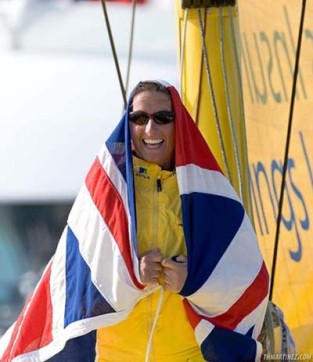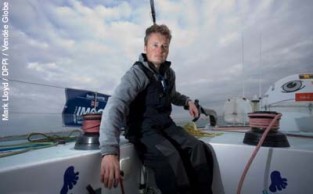Read a summary of the Vendee Globe's major events that saw only 11 boats finish
A brief synopsis of the sixth Vendee Globe, from 9 November 2008 to the 15 March 2009.
The race was won by Michel Desjoyeaux (Foncia, left) on 1 February. The Austrian Norbert Sedlacek brought it to an end 42 days later by completing his voyage yesterday.
9 November:Race begins. 30 skippers, including 19 new boats, set out. The moderate south-westerly wind soon increases to a major storm in the Bay of Biscay. Four skippers return to Les Sables d’Olonne after a few hours of racing to make repairs – Dominique Wavre, Bernard Stamm, Alex Thomson and Michel Desjoyeaux.
11 November:The storm is merciless: Groupe Bel, Aquarelle.com and DCNS are dismasted. Two days later Alex Thomson announces he is to retire. Michel Desjoyeaux sets sail again after some quick repairs. Jean-Baptiste Dejeanty and Derek Hatfield return to carry out repairs. The fleet is led by Loïck Peyron, Sébastien Josse and Jean-Pierre Dick
21 November:In the lead for 8 days, Loïck Peyron is the first to cross the Equator. In the Doldrums, the gaps are still very small – the first five within 30 miles of each other and the first twelve within 200 miles (this close-contact racing would continue until the Indian Ocean). Desjoyeaux has already made up half of his deficit, which is down to 330 miles.
26 November:Jérémie Beyou is forced to retire in Brazil with broken spreaders on his Delta Dore. Jean-Baptiste Dejeanty set sail again from Les Sables d’Olonne. Sébastien Josse takes the lead. Armel Le Cléac’h is in third.
4 December:Michel Desjoyeaux is already back in the top ten. Speeds in the Roaring Forties reach above 18 knots.
6 December:Sébastien Josse is the first to enter the Indian Ocean, just as the first ice gate is moved because of icebergs. The race ends for the Basque, Unaï Basurko (Pakea Bizkaia) on 7 December after his starboard rudder breaks. He was to be the sixth competitor to be forced out of the race. Desjoyeaux is back to within 100 miles of the leader.
10 December:Loïck Peyron’s Gitana Eighty is dismasted and he retires five days later – another favourite out of the race. Only 23 boats are left in the race. Jean-Pierre Dick takes the lead.
12 December:The keel head breaks on Temenos II. Dominique Wavre heads for the Kerguelens, where he’s joined by Bernard Stamm (damaged bowsprit and rudders). A horrible pit stop for Bernard Stamm – in the storm his boat is washed onto the rocks and smashed. The two Swiss sailors are forced out. Mike Golding takes the lead? but just for a few hours. Ecover is dismasted.
 16 December:Mike Golding (right) is out. At the rear, the youngest entrant Jean-Baptiste Dejeanty is also forced to retire (various damage). There are only 19 boats left after a month and a half of racing. Michel Desjoyeaux takes the lead? and never relinquishes it right up to the finish line. Meanwhile, the rudder on Paprec-Virbac 2 suffers damage and Jean-Pierre Dick heads north to carry out complicated repairs – which are successful.
16 December:Mike Golding (right) is out. At the rear, the youngest entrant Jean-Baptiste Dejeanty is also forced to retire (various damage). There are only 19 boats left after a month and a half of racing. Michel Desjoyeaux takes the lead? and never relinquishes it right up to the finish line. Meanwhile, the rudder on Paprec-Virbac 2 suffers damage and Jean-Pierre Dick heads north to carry out complicated repairs – which are successful.
18 – 20 December:The race takes a dramatic turn. Yann Eliès is seriously injured in a manoeuvre on the bow and suffers terribly on Generali, 800 miles to the south of Australia. Marc Guillemot and Sam Davies are diverted. The frigate Arunta takes off Yann and transports him to hospital where his broken femur is operated on. Doctors realise he also has a fractured pelvis and ribs.
23 December:Day 44. Halfway through the race. Michel Desjoyeaux is the first to cross the International Date Line to the south of New Zealand. As they enter the Pacific, Jourdain, Josse and Le Cam try to follow the pace set by Desjoyeaux, followed by two duos: Riou/Le Cléac’h and Davies/Guillemot. The latter stop on Christmas Day in the Auckland Islands to try and repair his damaged mast track.
27 December:Sébastien Josse’s boat is knocked down by a huge wave and sustains damage to the steering. Unable to carry out the repairs, he signals his retirement on 29 December. He is followed an hour and a half later by Canadian, Derek Hatfield. Boats are now down to sixteen. Michel Desjoyeaux increases his lead. Only Roland Jourdain and Jean Le Cam manage to keep up. Winds in excess of 45 knots are common.
1 January:Jean-Pierre Dick is forced to retire. The day before, he had hit a growler and this time it was to be definitive. On the 53rd day of the race, only half of the starting fleet are still racing. The leading seven are Desjoyeaux, Jourdain, Le Cam, Le Cléac’h, Riou, Guillemot and Samantha Davies – the leading Brit.
5 January:At 3h10, Foncia rounds the Horn after 56 days and 15 hours – two hours less than Jean Le Cam in 2005. Roland Jourdain follows 8 hours and 50 minutes later. The day before, Jonny Malbon (Artemis) retired with a damaged mainsail. 14 sailors are still racing.
 6 January:No answer from Jean Le Cam. 200 miles from the Horn, VM Matériaux loses her keel bulb and capsizes. An oil tanker is diverted and marks the position. Armel le Cléac’h and Vincent Riou head to the zone. Vincent Riou managed to recover Jean twenty hours later, but an outrigger breaks during the manoeuvre and PRB is dismasted. The episode gives rise to an unprecedented decision from the International Jury – Vincent Riou is to be ranked third – redress granted, without having any impact on the other participants’ rankings.
6 January:No answer from Jean Le Cam. 200 miles from the Horn, VM Matériaux loses her keel bulb and capsizes. An oil tanker is diverted and marks the position. Armel le Cléac’h and Vincent Riou head to the zone. Vincent Riou managed to recover Jean twenty hours later, but an outrigger breaks during the manoeuvre and PRB is dismasted. The episode gives rise to an unprecedented decision from the International Jury – Vincent Riou is to be ranked third – redress granted, without having any impact on the other participants’ rankings.
9 January:Veolia Environnement collides with a whale. Cracks appear at the foot of the mast and around the keel box. In second place, 178 miles from the leader, Roland Jourdain is the only one left with a real hope of challenging Michel Desjoyeaux.
11 January:Samantha Davies rounds the Horn in 4th place after Desjoyeaux, Jourdain and Le Cléac’h. The redress given for the rescue of Yann Eliès and Jean Le Cam were 11 hours for Armel Le Cléac’h, 82 hours for Marc Guillemot, 32 hours for Sam Davies.
15 January:A huge storm is forecast off Cape Horn for the trio of Brian Thompson, Dee Caffari and Arnaud Boissières. With winds averaging 65 knots and gusts up to 85, the seas are mountainous. Brian Thompson is forced to turn back to shelter off the island of los Estados. All three get through the storm without any major worries. Further back, still in the Pacific, Steve White, Rich Wilson, Raphaël Dinelli and Norbert Sedlacek are also suffering from the severe conditions.
20 January:Michel Desjoyeaux crosses the equator in 71 days and 17 hours, twenty hours ahead of Roland Jourdain. Behind Armel Le Cléac’h in third, a battle is raging between Samantha Davies and Marc Guillemot. The latter chose a winning option close to the coast of Brazil, but this led him to some more adventures, including being chased by angry fishermen after Safran got caught in their line.
26 January:In the North Atlantic, Desjoyeaux continues not to make any mistakes and extends his lead to 500 miles over Roland Jourdain. The Professor confesses he had seen a miracle, when his port rudder slipped out on Foncia a month earlier off New Zealand.
29 January:Veolia Environnement loses her keel. Roland Jourdain manages to sail his boat to the Azores, some 600 miles away, but is forced to retire when severe gales with 50 knot winds are forecast. Only 11 boats would finish the Vendée Globe.
1 February:At 15h11 GMT, Michel Desjoyeaux achieves a resounding victory in Les Sables d’Olonne, becoming the first sailor to win the Vendée Globe twice after his first triumph eight years earlier. The race record is smashed with a time of 84 days, 3 hours, 9 minutes and 8 seconds, at an average speed of 12.3 knots on the theoretical route and 14 knots over the 28,303 miles Foncia actually covered on the water. An incredible achievement particularly when we remember that he had set sail 40 hours after the fleet and was 670 miles behind on 15 November.
7 February:Armel Le Cléac’h crosses the finish line with a time of 89 days, 9 hours 39 minutes and 35 seconds. Brit Air’s speeds: 11.57 knots on the theoretical route and 12.7 knots over the 27,232 miles actually covered.
9 February:Fighting it out for third place is Samantha Davies on Roxy and Marc Guillemot’s Safran. Safran loses her keel, but the skipper continues even though he still had a thousand miles to sail.
14 February:Samantha Davies arrives back in Les Sables d’Olonne to become the first woman to finish this Vendée Globe. But she must wait for Marc Guillemot to finish. Due to his redress, Guillemot would take third place from her.
16 February:At 01h21 GMT, Marc Guillemot takes third place by 2 hours and 20 minutes. Brian Thompson and Dee Caffari arrive on the same day to take fifth and sixth place. Dee Caffari becomes the first woman to sail both ways around the world.
22 February:Arnaud Boissières (Akena Vérandas) finishes in seventh place, after 105 days and 2 hours, and on an old boat.
 26 February:In spite of a lot of damage, the courageous British sailor Steve White (right) completes his round the world race and takes eighth place – after 109 days at sea.
26 February:In spite of a lot of damage, the courageous British sailor Steve White (right) completes his round the world race and takes eighth place – after 109 days at sea.
10 March:The American, Rich Wilson finishes in ninth aboard Great American III, after 121 days.
14 March:Raphaël Dinelli completes his second Vendée Globe on his fourth attempt and gains two places by finishing tenth. He finished in more or less the same time as in 2005, improving by two hours on his previous race, with a time of 125 days and 2 hours. Aboard his Fondation Ocean Vital, Raphaël proved it was possible to sail around the world producing energy with a big wind generator and solar panels.
15 March:Austrian Norbert Sedlacek ends his race in eleventh place and brings this Vendée Globe to an end. The former tram driver will have spent four months and one week at sea – 42 days more than Michel Desjoyeaux.
23 May:Prize ceremony on the beach in Les Sables d’Olonne



